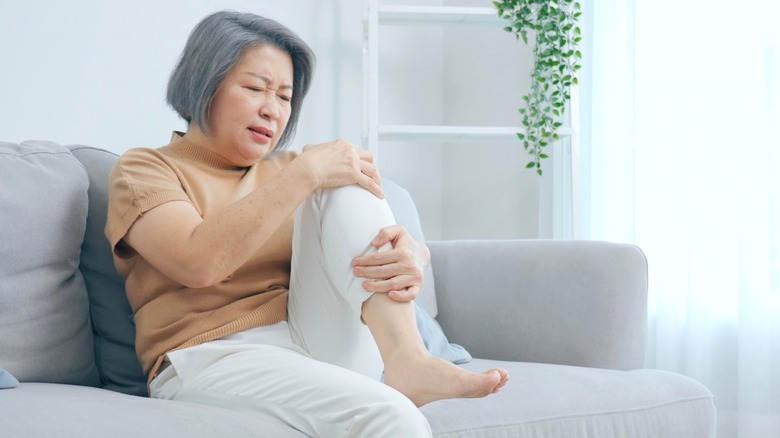The Best Sorts Of Workouts For People Who Have Gout
If you're currently experiencing gout, you're not alone. Gout affects over 9 million American adults, mostly impacting older people and men, according to JAMA Network. Additionally, there are certain factors that may increase your risk of developing the disease, such as obesity, diabetes, insulin resistance, and kidney issues.
Gout is a common type of arthritis impacting the joints. It causes inflammation due to deposits of sharp uric acid crystals and creates a condition known as hyperuricemia, which is characterized by intense joint pain, redness, and inflammation that can last for hours. Though the big toe joint is the area of the body where gout most commonly occurs, the experts at Mayo Clinic explain that sudden pain and other symptoms of gout can also occur in your ankles and knees as well as the joints in your wrists, hands, and fingers.
Research indicates that certain types of exercise can help mitigate gout symptoms. In a study published in the science journal PLoS ONE, results showed that low- to moderate-intensity physical activity reduced inflammation among participants. Though further research is needed, it appears that when used as an adjunct treatment choice in conjunction with other gout treatment methods recommended by a healthcare specialist, engaging in regular exercise in between gout flare-ups coincides with a greater chance that patients will experience milder or less frequent flare-ups, per PLoS ONE.
Moreover, experts at Cleveland Clinic state that exercise can prevent people from getting gout in the first place, as engaging in a consistent exercise regimen can help to reduce the stress on joints and lower the risk of obesity and other health problems that can increase the risk of developing gout.
Given these facts, you might wonder what specific exercises are best for people with gout.
The best workouts to do if you have gout
Though exercise is recommended between flare-ups, Healthline reports that exercising during a flare-up is not advisable. The reason you should avoid exercise during a gout attack is that inflammation is at its most acute and physical activity tends to enhance the discomfort. Even simple motions such as standing or walking can be incredibly painful.
After you experience a flare-up and are ready to take on exercise, it is important to avoid engaging in intense activities — such as high-intensity interval training (HIIT) workouts — to ensure you do not bring on another flare-up. Rather than running, consider walking, swimming, or cycling. Healthline advises moderate levels of these modes of exercise for 150 minutes a week according to the Physical Activity Guidelines for Americans to manage weight and support cardiovascular health.
With regard to exactly how much walking is advisable, the experts at Jackson Urological Associates, PC suggest a daily walk of at least 6,000 steps, with a goal of 10,000 steps. Other low-impact cardio they support for people dealing with gout includes dancing and climbing stairs. And if you're pressed for time, that's not a problem. A simple, yet comprehensive, seven-minute home workout can do a lot to support your bone health. The workout — which includes 30-second sets of jumping jacks, stomach crunches, lunges, planks, push-ups, and other easy movements with 10 seconds of recovery in between — will support a feeling of well-being that will help you better manage and prevent gout flare-ups.
Other ways to treat gout
Considering how gout symptoms are extremely painful and gout attacks can last as long as two weeks, it's understandable that those who experience the disease would look to whatever approved measures are available for relief and prevention.
Though there is no cure for gout, you can work with your medical provider to find the most appropriate treatment for your situation. For example, if you're experiencing a flare-up, your doctor may suggest ice packs in conjunction with medications such as a non-steroidal anti-inflammatory drug (NSAID), a corticosteroid, or colchicine, per NHS inform.
To prevent continuing attacks, experts also advise patients to make lifestyle changes such as improving their diet, taking medication to help lower uric acid levels, and losing weight.
Also, certain foods contain a type of chemical compound called "purines" that can create issues if these foods are highly present in your diet. Though purines are an essential component in the formation of DNA and RNA, the body breaks purines down into uric acid, which can raise the risk of developing gout if you consume a diet that is high in purine-rich foods. Examples of foods containing purines include red meat, organ meat, and some seafood and shellfish such as anchovies, sardines, mussels, and tuna.
Drinking alcohol can also increase the risk for gout, especially as you increase your alcohol intake, so it's important to minimize the consumption of alcoholic beverages.



